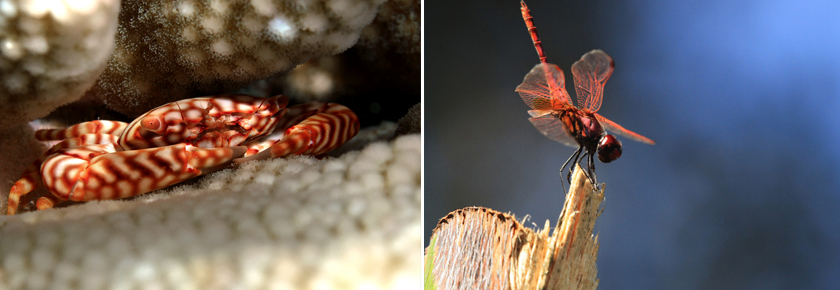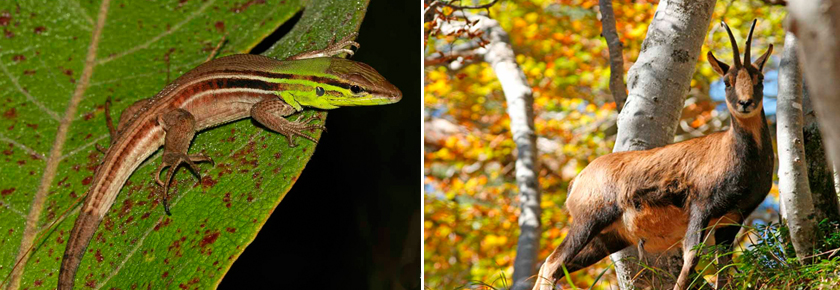
A national inventory of species is an organised process of data acquisition of species
The inventory is therefore a project which aims to establish a synthetic reference information on the distribution for the group concerned. The final validation defines a version of this inventory, generally associated with its publication as an atlas.
Toward News for an Atlas example

Trapezia flavopunctata Eydoux & Souleyet, 1842 © P.Bourjon & Trithemis annulata (Palisot de Beauvois, 1807) © J.Laignel
Since 1979, upon the request of the Ministry of Environment, the Muséum national d'Histoire naturelle coordinates the collection and organises the synthesizing of data on fauna and flora of metroplitan and overseas France. These data provide basic and essential knowledge of the natural heritage. These atlas are an essential basis to define the relative scarcity of species, assess their risk of extinction define "hotspots" of biodiversity, identify and assess the relevance of networks of protected areas, models the effects of climate change, etc. Their analysis allows to assess the status of the natural heritage and therefore to guide the policies of nature management both regionally and nationally.
The information gathered essentially concern the names of the observed species in the country, places and dates of observations of these species and the names of the observers. Further information can also be optionally collected (altitude of observation, stage of development, gender, etc.). Data collection is carried out in special operations of inventories, limited in time, but which may be repeated regularly. Opportunistic observation data may also consolidate these procedures, as well as the datasets present in the platforms of the Natural Heritage Inventory Information System (SINP).
National inventories are unifying projects for the naturalist community. Naturalists and learned societies, expert groups and public institutions are generally motivated to initiate and lead these projects. Amateur and professional naturalists gather themselves in collection networks on a voluntary basis. The Museum, within the framework of scientific responsibility entrusted to it by the Code of the Environment (Art. L. 411-5), monitors the projects, provides methodological support, provides tools (taxonomic repositories, capture tool CardObs ...) , and ultimately implements the data collected, to return them to the Natural Heritage Inventory Information System or the GBIF. Based on an analysis of needs and gaps, the Museum can organise inventories or solicit partners to complete them. The data is then made available to all as part of the Natural Heritage Inventory, in accordance with the agreements concluded with partners.
Key figures on national inventories (February 2013 Assessment)
* Grouped structure of pre-existing information
Status publication |
Level completeness | Métropole | Overseas (DOM) | COM |
|---|---|---|---|---|
| Published | Atlas (presence / non-detection) | 21 | 11 | 3 |
| Preliminary Atlas * (presence) | 7 | |||
| Being collected | Atlas (presence / non-detection) | 13 | 2 | 2 |
| Preliminary Atlas (presence) | 1 |
Number of distribution atlas:
Number of species processed (estimate) depending on the major subdivisions of living things, all atlas combined (ongoing or published, preliminary or completed):
| Métropole | Overseas (DOM) | |||||
|---|---|---|---|---|---|---|
| Guadeloupe | Martinique | Guiana | Mayotte | La Réunion | ||
| Vertebrates | 837 | 49 | 43 | 712 | 18 | 38 |
| Invertebrates | 1525 | 41 | 54 | 0 | 0 | 470 |
| Tracheophyte flora | 785 | 0 | 0 | 0 | 0 | 0 |
| Flora (excluding tracheophytes) | 0 | 0 | 0 | 0 | 0 | 0 |
| Fungus | 0 | 0 | 0 | 0 | 0 | 0 |
| COM | |||||
|---|---|---|---|---|---|
| New Caledonia | French Polynesia | Saint Pierre and Miquelon | TAAF | St Barth + St Martin | |
| Vertebrates | 182 | 55 | 20 | 33 | 40 |
| Invertebrates | 37 | 20 | 0 | 0 | 0 |
| Tracheophyte flora | 0 | 0 | 0 | 0 | 0 |
| Flora (excluding tracheophytes) | 0 | 0 | 0 | 0 | 0 |
| Fungus | 0 | 0 | 0 | 0 | 0 |
As a reminder, in metropolitan France: about 1,600 vertebrates, 40,000 Invertebrates; 15,000 fungus; 6,000 tracheophytes.
Source: TAXREF.
Number of species processed (estimate) depending on habitat, all atlas combined (ongoing or published, preliminary or completed):
| Métropole | Overseas (DOM) | |||||
|---|---|---|---|---|---|---|
| Guadeloupe | Martinique | Guiana | Mayotte | La Réunion | ||
| Marine | 505 | 22 | 22 | 14 | 18 | 13 |
| Amphihalin + Euryhalin | 22 | 0 | 18 | 80 | 0 | 24 |
| Continent | 2695 | 68 | 57 | 618 | 0 | 471 |
| COM | |||||
|---|---|---|---|---|---|
| New Caledonia | French Polynesia | Saint Pierre and Miquelon | TAAF | St Barth + St Martin | |
| Marine | 45 | 19 | 20 | 33 | 23 |
| Amphihalin + Euryhalin | 57 | 40 | 0 | 0 | 0 |
| Continent | 117 | 16 | 0 | 0 | 17 |
To contribute:
If you wish to transmit useful data for ongoing or future inventories, the Museum provides to naturalists a tool for the capture and management of data, CardObs (contact: cardobs@mnhn.fr).
A charter defines the conditions of supply and usage of the data between the partner and the INPN.

Kentropyx striata Daudin, 1802 © M.Dewynter & Rupicapra pyrenaica Bonaparte, 1845 © M.Bartoli